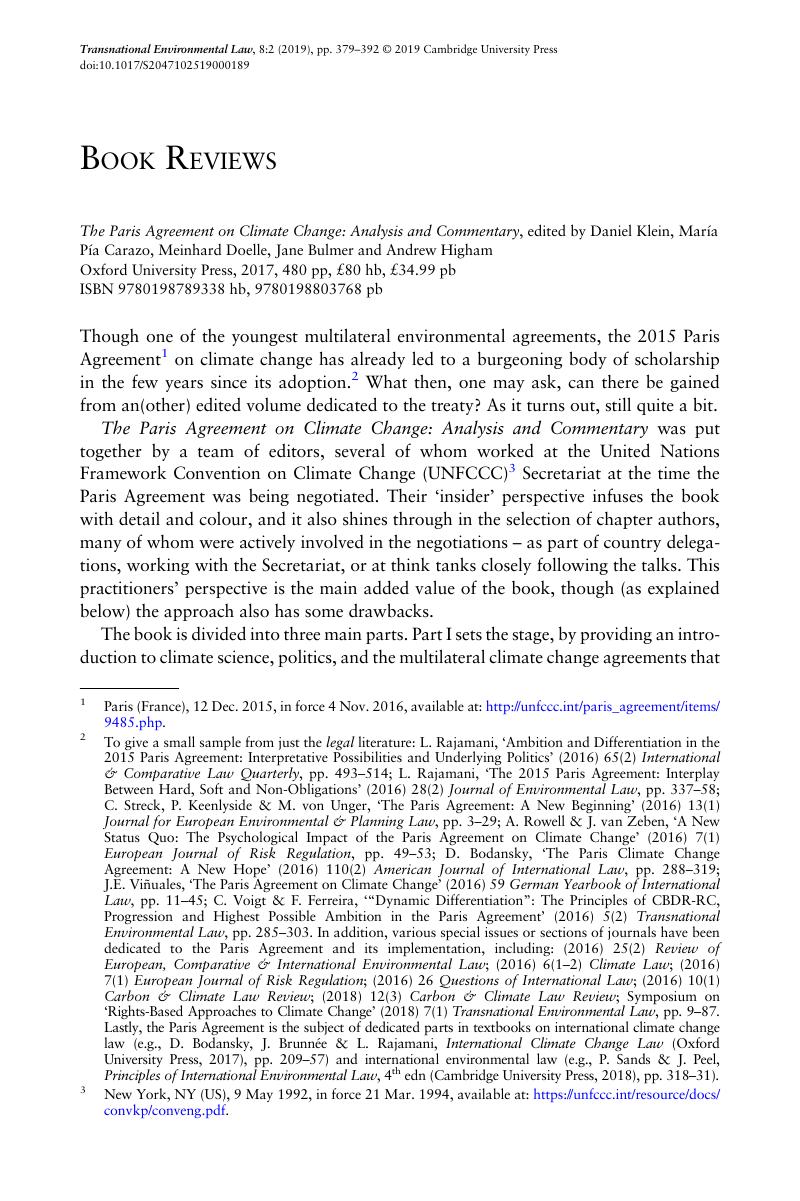No CrossRef data available.
Published online by Cambridge University Press: 18 July 2019

1 Paris (France), 12 Dec. 2015, in force 4 Nov. 2016, available at: http://unfccc.int/paris_agreement/items/9485.php.
2 To give a small sample from just the legal literature: Rajamani, L., ‘Ambition and Differentiation in the 2015 Paris Agreement: Interpretative Possibilities and Underlying Politics’ (2016) 65(2) International & Comparative Law Quarterly, pp. 493–514CrossRefGoogle Scholar; Rajamani, L., ‘The 2015 Paris Agreement: Interplay Between Hard, Soft and Non-Obligations’ (2016) 28(2) Journal of Environmental Law, pp. 337–58CrossRefGoogle Scholar; Streck, C., Keenlyside, P. & von Unger, M., ‘The Paris Agreement: A New Beginning’ (2016) 13(1) Journal for European Environmental & Planning Law, pp. 3–29CrossRefGoogle Scholar; Rowell, A. & van Zeben, J., ‘A New Status Quo: The Psychological Impact of the Paris Agreement on Climate Change’ (2016) 7(1) European Journal of Risk Regulation, pp. 49–53CrossRefGoogle Scholar; Bodansky, D., ‘The Paris Climate Change Agreement: A New Hope’ (2016) 110(2) American Journal of International Law, pp. 288–319CrossRefGoogle Scholar; Viñuales, J.E., ‘The Paris Agreement on Climate Change’ (2016) 59 German Yearbook of International Law, pp. 11–45Google Scholar; Ferreira, C. Voigt & F., ‘“Dynamic Differentiation”: The Principles of CBDR-RC, Progression and Highest Possible Ambition in the Paris Agreement’ (2016) 5(2) Transnational Environmental Law, pp. 285–303Google Scholar. In addition, various special issues or sections of journals have been dedicated to the Paris Agreement and its implementation, including: (2016) 25(2) Review of European, Comparative & International Environmental Law; (2016) 6(1–2) Climate Law; (2016) 7(1) European Journal of Risk Regulation; (2016) 26 Questions of International Law; (2016) 10(1) Carbon & Climate Law Review; (2018) 12(3) Carbon & Climate Law Review; Symposium on ‘Rights-Based Approaches to Climate Change’ (2018) 7(1) Transnational Environmental Law, pp. 9–87. Lastly, the Paris Agreement is the subject of dedicated parts in textbooks on international climate change law (e.g., D. Bodansky, J. Brunnée & L. Rajamani, International Climate Change Law (Oxford University Press, 2017), pp. 209–57) and international environmental law (e.g., Sands, P. & Peel, J., Principles of International Environmental Law, 4th edn (Cambridge University Press, 2018), pp. 318–31)CrossRefGoogle Scholar.
3 New York, NY (US), 9 May 1992, in force 21 Mar. 1994, available at: https://unfccc.int/resource/docs/convkp/conveng.pdf.
4 Kyoto (Japan), 11 Dec. 1997, in force 16 Feb. 2005, available at: http://unfccc.int/resource/docs/convkp/kpeng.pdf.
5 For an example of such an analysis, see B. Mayer, ‘International Law Obligations Arising in relation to Nationally Determined Contributions’ (2018) 7(2) Transnational Environmental Law, pp. 251–75.
6 The set of decisions adopted here is available at: https://unfccc.int/decisions_katowice.
7 See, e.g., Brunnée, L. Rajamani & J., ‘The Legality of Downgrading Nationally Determined Contributions under the Paris Agreement: Lessons from the US Disengagement’ (2017) 29(3) Journal of Environmental Law, pp. 537–51Google Scholar.
8 Notably Bodansky, Brunnée & Rajamani, n. 2 above; and Mayer, B., The International Law on Climate Change (Cambridge University Press, 2018)Google Scholar.